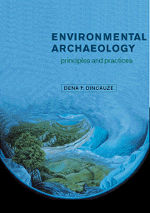Book contents
- Frontmatter
- Contents
- List of figures
- List of tables
- Preface
- Acknowledgments
- Glossary
- PART I INTRODUCTION
- 1 ENVIRONMENTAL ARCHAEOLOGY AND HUMAN ECOLOGY
- 2 CONCEPTS FOR PALEOENVIRONMENTAL RECONSTRUCTION
- 3 MECHANISMS OF ENVIRONMENTAL CHANGE
- 4 HUMAN RESPONSES TO ENVIRONMENTAL CHANGE
- PART II CHRONOLOGY
- PART III CLIMATE
- PART IV GEOMORPHOLOGY
- PART V SEDIMENTS AND SOILS
- PART VI VEGETATION
- PART VII FAUNA
- PART VIII INTEGRATION
- References
- Index
2 - CONCEPTS FOR PALEOENVIRONMENTAL RECONSTRUCTION
Published online by Cambridge University Press: 20 January 2010
- Frontmatter
- Contents
- List of figures
- List of tables
- Preface
- Acknowledgments
- Glossary
- PART I INTRODUCTION
- 1 ENVIRONMENTAL ARCHAEOLOGY AND HUMAN ECOLOGY
- 2 CONCEPTS FOR PALEOENVIRONMENTAL RECONSTRUCTION
- 3 MECHANISMS OF ENVIRONMENTAL CHANGE
- 4 HUMAN RESPONSES TO ENVIRONMENTAL CHANGE
- PART II CHRONOLOGY
- PART III CLIMATE
- PART IV GEOMORPHOLOGY
- PART V SEDIMENTS AND SOILS
- PART VI VEGETATION
- PART VII FAUNA
- PART VIII INTEGRATION
- References
- Index
Summary
If the theories behind borrowed concepts are not clearly understood and taken into account in the application of the concepts, not only will the results of the concept application be suspect, but misunderstandings may arise between practitioners of the science from which the concept was borrowed and the concept-borrowing archaeologists.
CREMEENS AND HART 1995: 16The study of the human past requires knowledge of the solar system as well as of the home planet and its geophysical and biological systems, of which we are inextricably a part. The eternal fascination of archaeological research is that it challenges all our creativity, discipline, and enthusiasms; scarcely any knowledge is irrelevant to it. That is especially true of environmental archaeology – the study of paleoenvironments as human habitats. Habitats pose problems and opportunities for resident organisms of whatever size and complexity; humans are not excepted from this imposition. If we are to understand the behaviors of human beings in their unique cultural contexts, we must be able to define and examine crucial aspects of their habitats. Humanenvironments, originally restricted to sub-Saharan Africa, now include the entire world and parts of space – so, the study of human ecology, which is at the core of environmental archaeology (Butzer 1982), is necessarily comprehensive and resolutely dynamic. Not surprisingly, it is still very immature and experimental.
The means for defining and interpreting elements of human environments, both past and present, are expanding. Archaeologists, especially environmental archaeologists, employ techniques and concepts developed in the disciplines of anthropology, biology, ecology, zoology, botany, geology, oceanography, climatology, and pedology (soils), among others. Of course, no one can be expert in all these subjects; both compromise and consultation are required.
- Type
- Chapter
- Information
- Environmental ArchaeologyPrinciples and Practice, pp. 20 - 35Publisher: Cambridge University PressPrint publication year: 2000
- 1
- Cited by

